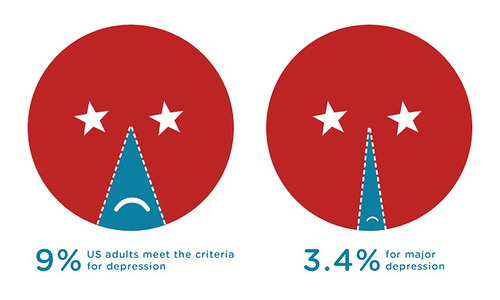Published: August 19, 2011
Men More Likely To Develop Substance Abuse, Antisocial Problems; Women More Likely To Develop Anxiety, Depression

When it comes to mental illness, the sexes are different: Women are more likely to be diagnosed with anxiety or depression, while men tend toward substance abuse or antisocial disorders, according to a new study published by the American Psychological Association.
Published online in APA’s Journal of Abnormal Psychology, the study looked at the prevalence by gender of different types of common mental illnesses. The researchers also found that women with anxiety disorders are more likely to internalize emotions, which typically results in withdrawal, loneliness and depression. Men, on the other hand, are more likely to externalize emotions, which leads to aggressive, impulsive, coercive and noncompliant behaviour, according to the study. The researchers demonstrated that it was differences in these liabilities to internalize and to externalize that accounted for gender differences in prevalence rates of many mental disorders. [continue reading…]
Published: August 18, 2011
We make decisions all our lives—so you’d think we’d get better and better at it. Yet research has shown that younger adults are better decision makers than older ones. Some Texas psychologists, puzzled by these findings, suspected the experiments were biased toward younger brains.
So, rather than testing the ability to make decisions one at a time without regard to past or future, as earlier research did, these psychologists designed a model requiring participants to evaluate each result in order to strategize the next choice, more like decision making in the real world.
The results: The older decision makers trounced their juniors. The findings will be published in an upcoming issue of Psychological Science, a journal of the Association for Psychological Science. [continue reading…]
Published: August 17, 2011
Facial expressions convey strong cues for someone’s emotional state and the ability to interpret these cues is crucial in social interaction. This ability is known to be compromised in many psychiatric and neurological disorders, such as social anxiety or Korsakoff’s syndrome. New research has now revealed evidence that post-traumatic stress disorder (PTSD) is also characterized by changes in the way the brain processes specific emotions and that certain aspects of this disorder could be understood as a consequence of the altered processing of emotional cues. The findings are reported in the September 2011 issue of Elsevier’s Cortex.
Dr. Ervin Poljac from the International University of Sarajevo and the University of Leuven together with Dr. Barbara Montagne from the Radboud University Nijmegen Medical Centre and Prof. Edward de Haan from the University of Amsterdam, investigated emotional processing in a group of war veterans with symptoms developed after prolonged exposure to combat-related traumatic events. PTSD is already known to be associated with difficulties in experiencing, identifying, and describing emotions, the new study however specifically examined the participants’ ability to recognize particular emotional facial expressions. Participants were shown short video clips of emotional faces representing one of the six basic emotions (happiness, anger, fear, surprise, disgust and sadness). Compared to healthy subjects, the participants with PTSD were less able to recognize two emotions in particular: fear and sadness.
This is the first study to show impairment in the processing of specific emotions in PTSD. Results could be helpful not only in providing further insights into this disorder, but also in the development of new ways of assessing PTSD and the development of more detailed prognostic models. At the same time these results can betaken into account when designing therapeutic interventions.
Source: Elsevier : Ervin Poljac, Barbara Montagne, Edward H.F. de Haan, “Reduced recognition of fear and sadness in post-traumatic stress disorder,” Cortex, Volume 47, Issue 8, Italy: Elsevier, September 2011.
Published: August 17, 2011

© istockphoto
n unexpected discovery has led scientists to open an intriguing new window into the human brain, via the visual system.
Their finding may have implications for better understanding of states such as sleep, epilepsy and anaesthesia say the research team leaders Dr Sam Solomon and Professor Paul Martin of The Vision Centre and The University of Sydney.
Potentially it could open up a new pathway for manipulating brain rhythms to manage disorders such as insomnia and epilepsy, the team speculate in an article published today in the Proceedings of the National Academy of Sciences of the USA.
“It was purely a chance observation we made while we were activating the three cell layers of the lateral geniculate nucleus (LGN), which is the part where the optic nerve actually connects to the brain,” Prof. Martin recounts.
Two of these layers are linked with our ability to perceive edges and movement, he explains. The third, koniocellular or ‘K’ layer, is much more primitive – part of our deep evolutionary ancestry – and its function is still mysterious.“When we stopped applying a stimulus, two of the three layers ceased to respond while the K layer continued to pulse, slowly and rhythmically – like a sleeping brain.”
At the suggestion of a colleague, the research team then compared the signal from the K cells to an EEG readout from the brain itself: “To our surprise and delight we found the two were marching in time,” Dr Solomon says. The observation has provided physical evidence to support a scientific theory that the more primitive parts of the brain serve as regulators for the more advanced parts, responsible for conscious thought and feelings.It could also lead to a deeper scientific understanding of the nature of sleep and unconsciousness. [continue reading…]


